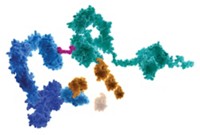Advertisement
Grab your lab coat. Let's get started
Welcome!
Welcome!
Create an account below to get 6 C&EN articles per month, receive newsletters and more - all free.
It seems this is your first time logging in online. Please enter the following information to continue.
As an ACS member you automatically get access to this site. All we need is few more details to create your reading experience.
Not you? Sign in with a different account.
Not you? Sign in with a different account.
ERROR 1
ERROR 1
ERROR 2
ERROR 2
ERROR 2
ERROR 2
ERROR 2
Password and Confirm password must match.
If you have an ACS member number, please enter it here so we can link this account to your membership. (optional)
ERROR 2
ACS values your privacy. By submitting your information, you are gaining access to C&EN and subscribing to our weekly newsletter. We use the information you provide to make your reading experience better, and we will never sell your data to third party members.
Business
Creative Contracts
Flexibility in deal-making with biotech partners enables Celgene to build a pipeline
by Lisa M. Jarvis
December 9, 2013
| A version of this story appeared in
Volume 91, Issue 49

When major pharmaceutical companies form drug development pacts with small biotech firms, they like to talk about embracing the nimbleness, entrepreneurial spirit, and cutting-edge science of their partners. But the reality is that the big firms often wind up smothering the innovation that attracted them in the first place.
One midsized biotech firm thinks it has figured out how to give those partners room to breathe. Through creative deal-making, Summit, N.J.-based Celgene has managed to gain a foothold in some of the most promising areas of oncology drug discovery. Such deals are necessary for Celgene because, unlike its larger competitors, it conducts little research of its own.
George Golumbeski, Celgene’s head of business development, attributes the firm’s success to flexibility in crafting deals and a deep trust in its partners. But he knows that the biotech ecosystem his company relies on is fragile, so he’s also exploring how those partnering skills can be applied to cultivating science at its most nascent stage.
As Golumbeski sees it, Celgene’s partnerships differ from the industry norm in several ways. One distinction is the company’s willingness to give biotech partners enough money to sufficiently advance scientific discoveries. Too often, he says, investors will give a company just enough cash to reach its next major milestone; as a consequence, biotechs find themselves cutting corners and not fully developing their technology platforms. “We don’t fund cavalierly, but we fund for success, not survival,” he says.
Notable Transactions: Celgene Has Been An Active Dealmaker Over The Past Two Years
January 2012: Avila
$350 million to buy the developer of covalent drugs
April 2012: Epizyme
$90 million for rights outside the U.S. to histone methyltransferase inhibitors
October 2012: VentiRx Pharmaceuticals
$35 million for firm’s VTX-2337, a TLR8 agonist to treat cancer
December 2012: Sutro
Deal to develop antibody-drug conjugates and bispecific antibodies
March 2013: Bluebird Bio
Agreement to pursue oncology gene therapies
March 2013: Presage Biosciences
$13 million to develop drug combinations for solid tumors
April 2013: Forma Therapeutics
Pact to develop cancer drugs against protein homeostasis targets
May 2013: Concert Pharmaceuticals
Agreement to develop deuterium-modified compounds for cancer and inflammation
June 2013: MorphoSys
$152 million for rights to MOR202, an antibody against CD38
July 2013: Acetylon
$100 million for access to three histone deacetylase inhibitors
October 2013: PharmAkea Therapeutics
$35 million investment in the developer of small molecules for cancer and fibrotic diseases
December 2013: OncoMed Pharmaceuticals
$177.25 million for rights to six anticancer stem cell product candidates
SOURCE: Companies
Deal structures are also fluid and vary on the basis of a partner’s long-term goals, Golumbeski says. Some companies want to eventually go public, whereas others seek to be acquired after they’ve accrued value. Celgene says it tries to craft a deal that respects its partner’s aspirations.
Empowering partners can require big money. Last year, Celgene shelled out $90 million to Cambridge, Mass.-based Epizyme to jointly develop small molecules that block histone methyltransferases (HMTs), a family of 96 epigenetic enzymes implicated in cancer. Epizyme had identified 20 HMTs as worth developing drugs against, but it had the bandwidth to work on just a few of them. At the same time, Epizyme’s founders were interested in building a company to last.
In addition providing to a critical influx of cash, the deal with Celgene allowed Epizyme to keep the U.S. marketing rights for HMT inhibitors developed through the collaboration, explains Epizyme President Jason P. Rhodes. “It gave us the fuel to really do a whole bunch of things in parallel, and at the same time we retained enough to capture value for Epizyme,” he says.
In fact, Epizyme has since gone public, one of five of Celgene’s partners that made their Wall Street debut this year.
Before entering a deal, Celgene executives conduct deep due diligence on a biotech company’s scientific abilities, but once a partner is added to Celgene’s roster, it is given relative freedom to pursue its endeavors, Golumbeski notes. Celgene picks what it believes are the best companies in a given field, he says. “Why would we turn around and tell them what to do?”
Celgene’s biotech partners point to that inherent trust as a key differentiator from collaborations with larger companies. Whereas some deals are focused on checking off boxes—validating a target, generating a certain number of molecules, reaching a milestone in the clinic—Celgene takes a longer term view, partners say.
“They tend to let you run a little bit more and leverage what makes you special as a biotech rather than turn you into big pharma,” says Steve R. Tregay, chief executive officer of Forma Therapeutics. In April Forma joined with Celgene to develop cancer drugs against targets related to the regulation of protein homeostasis.
Although Celgene’s creative attitude toward deal-making has enabled it to establish an array of partners in recent years, the model works only with a vibrant biotech community to cull from. Golumbeski says he’s kept awake at night by worries over the health of the biotech ecosystem, which since the economic meltdown in 2008 has suffered as venture capitalists put fewer funds into new companies.
“Those of us who spend our professional lives in this arena are not seeing the most desirable number of assets out there,” Golumbeski notes. “We will do more deals of the ilk we’ve done in the past, but I think we’d do even more if we could find them.”
Celgene sees the need to play a larger part in developing fresh ideas, he says. One such effort is a partnership with the Leukemia & Lymphoma Society (LLS), which last year launched a program called Targets, Leads & Candidates as a vehicle for funding academic research. As the nonprofit’s first partner in the program, Celgene will provide financial support in exchange for an option to license any interesting molecules developed in the endeavor.
Golumbeski says the partnership recognizes not only the need to accelerate translational research but also the success LLS has had at picking promising biotechs working on blood cancers. Indeed, several of the companies funded by the nonprofit are also Celgene partners.
Another example of Celgene’s efforts to cultivate a healthy biotech ecosystem is its role in founding PharmAkea Therapeutics, a San Diego-based firm developing small-molecule drugs for oncology and fibrosis. Celgene provided seed funding for PharmAkea, which was launched last year by three former executives from Amira Pharmaceuticals, a small firm acquired by Bristol-Myers Squibb in 2011.
Then two months ago, Celgene committed $35 million to PharmAkea as part of a three-year research pact. The deal included an equity stake and an option for Celgene to buy the biotech down the road. Bay City Capital also kicked in $10 million in first-round, or Series A, financing.
Celgene is contemplating other novel deal structures, or embellishments to its existing template, to continue feeding new drugs into its pipeline. Golumbeski says he constantly asks himself this question: “What can we do to go beyond just normal deal-making to access innovation?” Celgene’s future depends on it.




Join the conversation
Contact the reporter
Submit a Letter to the Editor for publication
Engage with us on Twitter